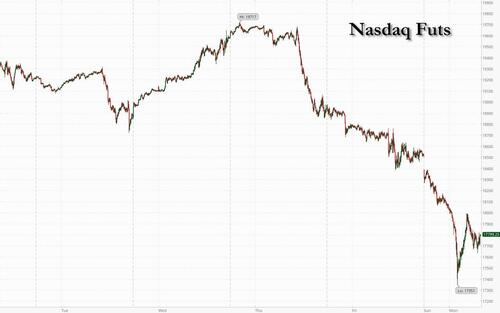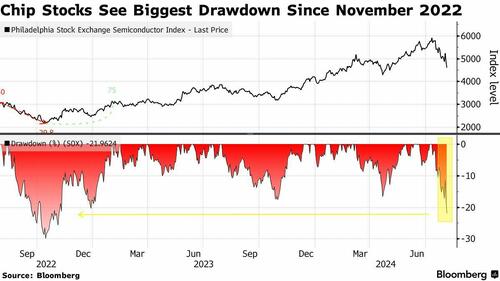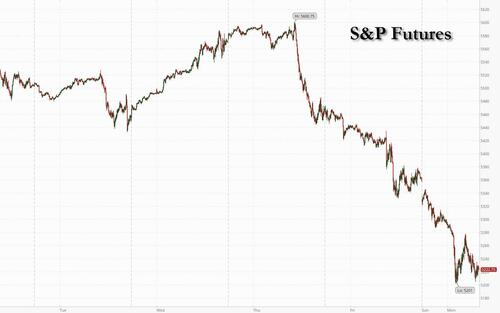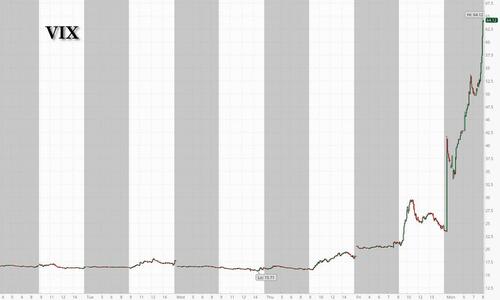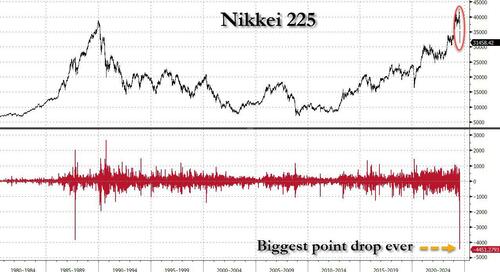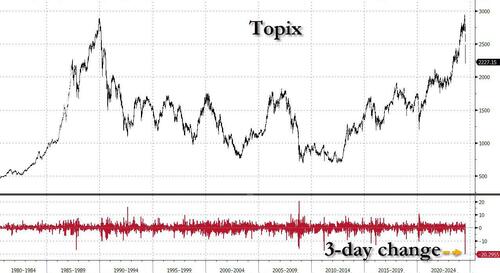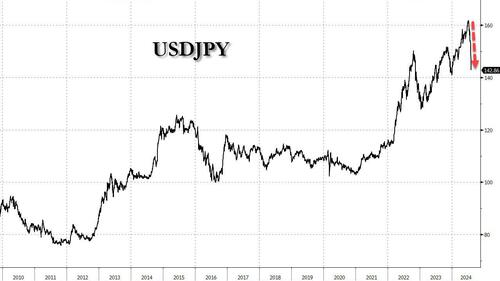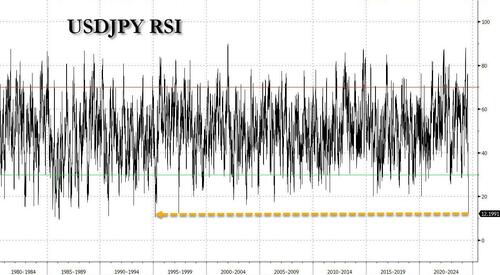

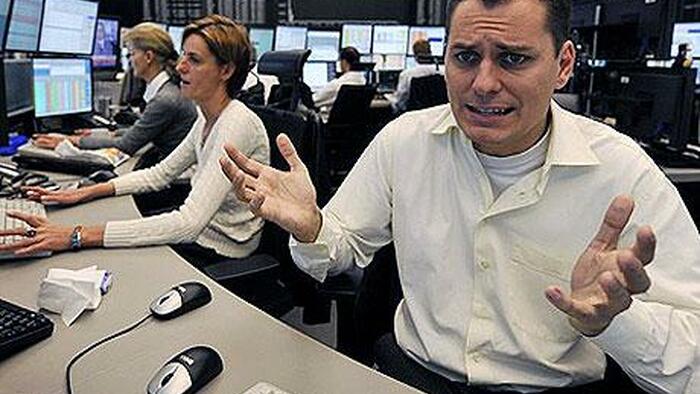
Good morning and welcome to a global market meltdown, sparked by last week's catastrophic BOJ decision to hike rates by 0.15bps which in turn crushed the $20 trillion yen carry trade, sent the yen exploding higher and wiping out trillions in highly levered investments, leading to a cascade of selling and forced liquidations which has resulted a historic market crash in Japan and a rout everywhere else.
In the US, futures are sharply lower with tech plunging as the global AI/Semis trade - itself a byproduct of the carry trade - is sold and small-caps are re-shorted. The Nasdaq 100 is set for its biggest opening drop in more than four years, as investors bracing for days of volatility amid rising concerns over a slowing US economy and overheated gains in the tech sector. Nasdaq 100 futures fell as much as 6.5% before paring losses to about 4.5%. That puts the tech-heavy index on track for its worst open since the pandemic days of March 2020.
The Nasdaq dropped into a correction Friday as investors freaked out over elevated valuations and the high cash outlay for investments in artificial intelligence. The Philadelphia Semiconductor Index is already in a bear market, tumbling 22% from a peak, even before Monday’s open.
Meanwhile, S&P 500 futures were down 3.0% while those tracking the Dow Jones Industrial Average declined 1.6%.
While both Nasdaq and Russell futures have pared their largest overnight losses, brace for more waves of selling as the VIX spikes above 62 and forces margin call after margin call, and volatility sellers are carted out...
... the highest print since the Covid crash when it peaked just over 80.
While US futures are a bloodbath, nobody had it as bad as Japan whose benchmark Nikkei 225 index recorded its worst-ever daily sell-off on Monday, losing 4,451.28 points from the previous day's closing amid panic selling triggered by fears of a possible U.S. recession and the yen's strength.
The sell-off was the largest ever in history and worse than in the Black Monday crash of October 1987, when it lost 3,836.48 points. The average closed down 12.4% to 31,458.42. On a percentage basis it wasn't much better, with the Nikkei's peer, Topix, tumbling -12.2%, its biggest one day drop since the 1987 stock market crash and the second worst day since data begins in 1949; the index is poised for its biggest three-day drop on record.
Turbulence in Japan, where the central bank started to raise interest rates as the Fed looks to cut in a historic mistake that has already wiped out trillions in value, is also having ripple effects across global markets of various asset classes. This is due to moves to reverse carry trades, in which investors had borrowed at lower rates in Japan to fund purchases of higher-yielding assets elsewhere, and nowhere has this been felt more than the yen: the USDJPY is down a record 20 big figures from 162 just a few weeks ago to 142 this morning, tumbling more than 3% since Friday.
The constant selling has pushed the USDJPY RSI to the most oversold level since 1995.
“With yen carry trades now being unwound quickly, not only has the Japanese currency notably broken its depreciation trend against all major units, but risk assets that those trades were financed with are also being sold off,” wrote Asymmetric Advisors strategist Amir Anvarzadeh, in a note to clients.
Back to the US, looking at the premarket, it's a tech rout for understandable reasons: many of the best performing stocks were direct beneficiaries of the leverage afforded by the carry trade and sure enough, all the Mag 7 names are crashing: NVDA -9.3%, AAPL -8.6%, TSLA -7.4%, MSFT -4.5%, AMZN -3%, META -6%, GOOG -5% and Semis are under pressure. Here are all the most notable premarket movers:
“In these sorts of scenarios, investors need to be careful,” said Ben Barringer, an analyst at Quilter Cheviot. “When sentiment begins to sour, the falls become more extreme than perhaps they should be. The next few weeks is likely to be a volatile one for tech stocks as this new environment plays out.”
While the US may have just hit $35 trillion in debt for now that is of secondary concern amid a global flight to safety, and bond yields are lower with the yield curve bull steepening and 2s/10s ~4.5bps from being fully dis-inverted as the 10Y tumbles to 3.72%. Today’s macro focus is ISM-Srvcs (51.0 survey vs. 48.8 prior), Senior Loan Officer Survey, and 2x Fedspeakers.
“With the summer low liquidity, the still heavy trend plays that need unwinding and the VIX sky-high, this selloff move could go on for a few days,” said Florian Ielpo, head of macro research at Lombard Odier Asset Management. Still, “the macro picture itself is not as bad as the market seems to think.”
Concerns over health of the US economy took center stage after Friday’s data pointed to rising unemployment levels in July, triggering a closely watched recession indicator and stoking fears that the Federal Reserve hasn’t moved quickly enough to cut interest rates. Investors bid up haven assets such as the yen, while Cboe VIX August futures spiked.
“The key point is the current shift in narrative, from no landing to soft landing,” said Florian Ielpo, the head of macro research at Lombard Odier Asset Management. “That risk was poorly priced and investors shifting gears fast explains the extent of the move.”
Elsewhere, Treasuries climbed as traders boosted bets on aggressive monetary policy easing by the Federal Reserve this year, with odds of an emergency meeting rising to 25%. US two-year yields fall 11bps to 3.77%.
In FX, we already covered the main highlights: the yen soared 3.2% against the greenback, pulling USDJPY down to ~142.05. The Swiss franc also outperforms, rising 1%, while the euro adds 0.4%. Bitcoin slumps over 10%.
In rates, Treasuries retained about half of their steep, front-end-led gains during Asia session and European morning, with 2-year yields richer by 13bp at around 3.75% after falling nearly 27bp Friday. US yields remain richer by 13bp to 4bp across the curve in an aggressive bull-steepening move that has 2s10s spread wider by almost 8bp and approaching dis-inversion for the first time since July 2022. US 10-year yields trade around 3.75% after reaching lowest since June 2023. Investors continue to price in aggressive rate cuts by the Federal Reserve, with about 55bp of easing now priced in for September FOMC meeting, 100bp by November’s. In other words, there is about 20% odds of an emergency rate cut already priced in. Similar gains seen in core European rates, where 2-year German yields are lower by around 11bp on the day. US session includes ISM services data at 10am New York time.
In commodities, oil prices decline, with WTI falling 1.9% to trade near $72.10 a barrel. Spot gold falls $18 to around $2,425/oz.
US economic data slate includes July S&P Global US services PMI (9:45am) and ISM services index (10am), and Fed’s Senior Loan Officer Opinion survey (2pm). Scheduled Fed speaker slate includes Goolsbee (8:30am) and Daly (5pm).
Market Snapshot
Top Overnight News
A more detailed look at global markets courtesy of Newsquawk
APAC stocks mostly slumped following last Friday's continued sell-off on Wall St owing to disappointing jobs data which sparked recession concerns, while heightened tensions in the Middle East linger as markets await Iran's retaliation. ASX 200 declined with tech, financials and real estate leading the broad retreat seen across all sectors. Nikkei 225 continued its aggressive slide and dipped beneath the 33,000 level for the first time since early January, while the index entered into a bear market along with the Topix. Hang Seng and Shanghai Comp. showed early resilience with the mainland initially kept afloat after Caixin Services PMI topped forecasts, while China recently laid out its priorities to spur consumer spending and the State Council designated 20 key steps to expand basic consumption. However, the bourses later conformed to global losses. Nikkei 225 unofficially closes at 31458, -12.4%; closes with a record daily points fall, exceeding the drop on Black Monday in October 1987
Top Asian News
European bourses opened with marked downside, following the APAC pressure post-NFP with sentiment hit further by updates concerning Apple and Nvidia; since, benchmarks have lifted slightly off worst but remain under marked pressure, Euro Stoxx 50 -2.3%. In brief, APAC pressure was pronounced with circuit breakers triggered in Japan and South Korea while the Nikkei 225 closed with a record daily points fall. Sectors in the red, Energy lags as crude benchmarks come under renewed pressure with Tech hit on sentiment and AAPL/NVDA while Banks slump as yields fall and pricing for central bank easing lifts. Infineon opened as the DAX 40 laggard after missing forecasts, narrowing guidance and announcing layoffs.
Stateside, futures in the red given the above but have begun to consolidate just off worst levels with newsflow light and as we await ISM Services & Fed speak for direction; ES -2.4%, NQ -3.9%. Bloomberg headlines this morning suggested that traders are pricing a 60% chance that the Fed will cut rates by 25bps in the next week.
Top European News
FX
Fixed Income
Commodities
Geopolitics: Middle East
Geopolitics: Other
US Event Calendar

